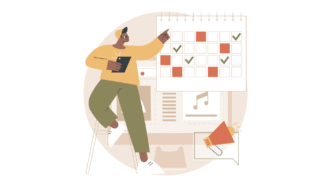LESSON OVERVIEW
In this lesson, students watch a video about different types of skills, learn useful vocabulary, and practise talking about hard and soft skills.
VOCABULARY
The lesson starts with a task in which students talk about some photos of people learning and say whether they would like to be in these situations. Then, they read sentences and find verbs which go with the noun ‘skills’ (e.g. improve, work on, measure). They find two pairs of synonyms among the verbs. After that, students find different types of skills mentioned in the statements in the previous exercise (e.g. computer skills, communication skills, presentation skills) and spend some time talking about hard and soft skills. Their task is to give examples of the skills, say which ones they would like to develop, whether someone taught them the skills when they were children, etc. They also brainstorm how someone could improve these skills.
HARD AND SOFT SKILLS
Before watching the video, students look at some pictures and try to guess the difference between hard and soft skills. Then, they watch the video and check their answers. Before the second viewing, students look at seven sentences and decide which skills they describe. They watch the video again to see if they were right. After the viewing part, students create different skills by matching their halves (e.g. being a good leader, time management). Then, they practise talking about hard and soft skills. First, they categorize skills. If they think some skills can be both hard and soft, they need to explain why. Students also talk about the importance of soft skills in the workplace. Finally, students look at four categories and decide which three best fit each category (e.g. ‘most important in the job market today’).
Subscribe to unlock these and many other Standalone lesson lesson plans with the Unlimited planWORKSHEETS












Hi Ewa! Thank you for this great lesson plan! I used it with a pair of students last week and they loved all the talking points as well as the vocabulary focus of this lesson 😉
That is really great to hear, Inna! Thanks for your feedback 🙂
The lesson is great, but I believe you should also have the slides not only the pdf file.
Oh I found the slides, forget what I said.
Hi Ewa thank you for this wonderful lesson. I only wanna say that there is a mistake in the teacher s version.
The synonym of work on = practise.
work on = improve = develop , practise = use.
Thanks!
I don’t think it’s necessary to add ‘use’ here, as it is not a synonym of any of the words. ‘Improve’ and ‘develop’ mean ‘to make better’, and ‘work on’ and ‘practise’ mean ‘to spend time doing something’.
It is really helpful
Thank you so much for such a useful lesson plan:))))
Hi! It is a very interesting lesson plan! My HR A2 student was engrossed by this lesson!
That is so good to hear, Valentyna! Thanks!
loveeeeed
Wow! Thanks 🙂
great
Happy to hear that 🙂
Another nice lesson. Thank you! One small thing though regarding slides 5 and 6. Because the clause “which go with noun skills” is a restrictive clause (it is essential to the meaning of the sentence and specifies which verbs you should find) the sentence should read “Read the sentences and underline seven verbs THAT go with the noun skills.” Thanks again for all you do.
Hi there! I’m glad you like the lesson 🙂
When it comes to ‘which’ and ‘that’, I believe both can be used to introduce a restrictive clause so the rubric you are referring to is correct. Please see some examples here.